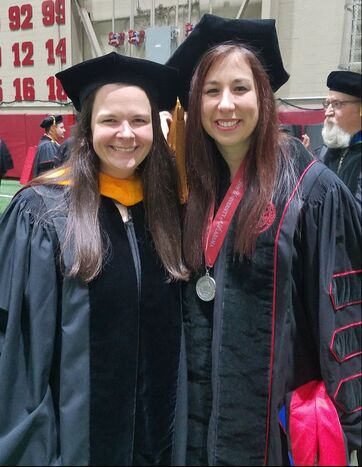Lauren Meaux and Dr. Cox Published in Journal of Aggression, Conflict and Peace Research!11/26/2020 *Meaux, L.T., *Doran, S.C., & Cox, J. (2020). Aberration of mind or soul: The role of media in perceptions of mass violence. Journal of Aggression, Conflict and Peace Research, 12, 209-222.
Unconscious biases against certain groups aid in forming assumptions which may be promulgated in the USA via popular news media linking rare but memorable violent acts with specific groups. However, the relationship between marginalized group association, assumptions regarding the motive for violent acts and individual media consumption has never been directly examined. This study aims to directly examine this relationship. In the present study, individuals read a vignette of a mass shooting in which the perpetrator’s implied religion (i.e. Islam or unknown religion) was manipulated. Participants then indicated their assumptions regarding motive (i.e. terrorism or mental illness) and personal media consumption habits. Contrary to hypotheses, differences in assumed motive based on implied religion were not found; participants were not more likely to associate an assumed Muslim perpetrator with terrorism as a motive or consider the assumed non-Muslim perpetrator to be mentally ill. These unexpected findings are discussed in the context of the data-collection period, which coincidentally overlapped with a well-publicized act of domestic terrorism that led to a unique national debate regarding biased news coverage and associations between religion, ethnicity, terrorism and mental illness.
1 Comment
Cox, J., *Meaux, L.T., *Stanziani, M., *Coffey, C.A., & Daquin, J. (2019). Partiality in prosecution? Discretionary prosecutorial decision making and intimate partner violence. Journal of Interpersonal Violence.
In the United States, prosecutors are typically allotted a large amount of discretion when litigating a criminal case. Although some level of discretion is necessary for various reasons (e.g., lack of resources), concerns have arisen in both scholarly and popular discourse that prosecutorial discretion remains generally unchecked. Furthermore, research suggests prosecutors may be influenced by extralegal factors when making decisions about how to proceed with criminal charges. In this study, prosecutors responded to a case of alleged intimate partner violence, in which the sex and sexual orientation of the defendant and victim were manipulated. Neither sex nor sexual orientation impacted prosecutor choice to proceed with charges, the severity of the charge selected, or the harshness of the plea bargain offered. However, prosecutors were more willing to proceed without the victim’s cooperation when the victim was female and perceived heterosexual males as more aggressive than heterosexual females. These data suggest prosecutorial decision making in cases of intimate partner violence may not be unduly influenced by defendant/victim sex and sexual orientation. *Remmel, R.J., Glenn, A.L., & Cox, J. (2018). Biological evidence regarding psychopathy does not affect mock jury sentencing. Journal of Personality Disorders.
Research on the biological factors influencing criminal behavior is increasingly being introduced into court, necessitating research on how such evidence is perceived and influences decision makers. Research on how this evidence influences sentencing recommendations is inconclusive. In this study, we focus on biological evidence related to psychopathy, a construct commonly associated with criminal behavior. Approximately 800 community members were presented with a case vignette detailing an individual who is described as having a high level of psychopathic traits. Participants received either psychological information about psychopathy (i.e., no biological evidence), evidence the defendant had genetic risk factors for psychopathy, or written neuroimaging evidence the defendant had brain deficits associated with psychopathy. Participants then recommended a sentence. Overall, recommended sentence lengths did not differ between evidence conditions. These findings add to a growing body of research suggesting that biological evidence may not have as much of an influence on jurors as previously thought. Cox, J., Fairfax-Columbo, J., DeMatteo, D., Vitacco, M.J., *Kopkin, M.R., Titcomb Parrott, C., *Bownes, E. (2018). An update on the role of the Violence Risk Appraisal Guide and Historical Clinical Risk Management-20 in United States case law. Behavioral Sciences and the Law.
An individual's risk for future violent behavior may be considered in various legal contexts, including civil commitment, criminal sentencing, or suitability for parole. Among the assessment tools forensic evaluators use to assess violence risk are the Violence Risk Appraisal Guide (VRAG; Quinsey, Harris, Rice, & Cormier, 1998) and the Historical Clinical Risk Managment‐20 (HCR‐20)/Historical Clinical Risk Management‐20, Version 3 (HCR‐20V3) (Webster, Douglas, Eaves, & Hart, 1997 and Douglas, Hart, Webster, & Belfrage, 2013, respectively). Previous surveys and case law research suggest that these measures are widely used and perceived to be useful in aiding forensic clinicians. This study provides an update to Vitacco, Erickson, Kurus, and Apple (2012) and examines the use of the HCR‐20 and VRAG in United States case law. A LexisNexis review revealed 134 cases decided between 1 January 2010 and 21 December 2016 that included the HCR‐20, VRAG, or both. Results revealed that these measures are typically introduced by the prosecution to inform opinions regarding general violence risk. In addition, consistent with previous research, these data suggest the introduction of the HCR‐20 and VRAG is rarely challenged and, when challenged, these challenges are rarely successful. However, data suggest that courts and parole boards may focus on specific risk factors (e.g., lack of insight) at the expense of other, more objective factors. Finally, we offer suggestions for clinicians who have transitioned to the newest version of the HCR‐20. |
Archives
August 2022
Categories
All
|










